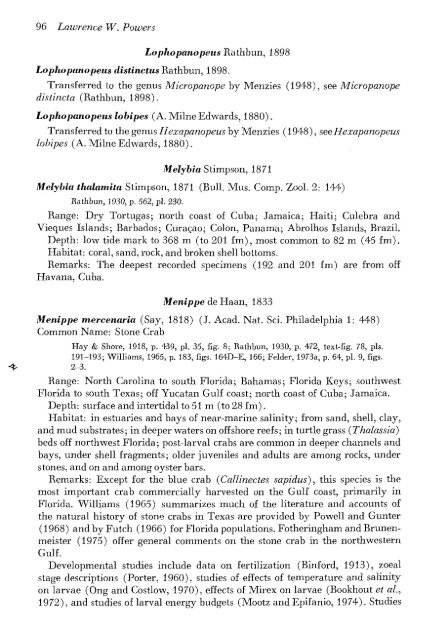You also want an ePaper? Increase the reach of your titles
YUMPU automatically turns print PDFs into web optimized ePapers that Google loves.
96 Lawrence W. Powers<br />
Lophopanopeus Rathhun, 1898<br />
Lophopanopeus distinclus Rathbun, 1898.<br />
Transferred to the genus Micropanope by Menzies (1948), see Micropanope<br />
distincta (Rathbun, 1898).<br />
Lophopanopeus lobipes (A. Milne Edwards, 1880).<br />
Transferred to the genus Hexapanopeus by Menzies (1948), see Hexapanopeus<br />
lobipes (A. Milne Edwards, 1880).<br />
MeZyfoia Stimpson, 1871<br />
Melyhia ihalamlla Stimpson, 1871 (Bull. Mus. Comp. Zool. 2: 144)<br />
Rathbun, \930, p. 562, pi. 230.<br />
Range: Dry Tortugas; north coast of Cuba; Jamaica; Haiti; Culebra and<br />
Vieques Islands; Barbados; Curagao; Colon, Panama; Abrolhos Islands, Brazil.<br />
Depth: low tide mark to 368 m (to 201 fm), most common to 82 m (45 fm).<br />
Habitat: coral, sand, rock, and broken shell bottoms.<br />
Remarks: The deepest recorded specimens (192 and 201 fm) are from off<br />
Havana, Cuba.<br />
Menippe de Haan, 1833<br />
Menippe mercenaria (Say, 1818) (J. Acad. Nat. Sci. Philadelphia 1: 448)<br />
Common Name: Stone Crab<br />
Hay & Shore, 1918, p. 439, pi. 35, fig. 8; Rathbun, 1930, p. 472, text-fig. 78, pis.<br />
191-193; Williams, 1965, p. 183, figs. 164D-E, 166; Felder, 1973a, p. 64, pi. 9, figs.<br />
2^3.<br />
Range: North Carolina to south Florida; Bahamas; Florida Keys; southwest<br />
Florida to south Texas; off Yucatan Gulf coast; north coast of Cuba; Jamaica.<br />
Depth: surface and intertidal to 51 m (to 28 fm).<br />
Habitat: in estuaries and bays of near-marine salinity; from sand, shell, clay,<br />
and mud substrates; in deeper waters on offshore reefs; in turtle grass (Thalassia)<br />
beds off northwest Florida; post-larval crabs are common in deeper channels and<br />
bays, under shell fragments; older juveniles and adults are among rocks, under<br />
stones, and on and among oyster bars.<br />
Remarks: Except for the blue crab (Callinectes sapidus), this species is the<br />
most important crab commercially harvested on the Gulf coast, primarily in<br />
Florida. Williams (1965) summarizes much of the literature and accounts of<br />
the natural history of stone crabs in Texas are provided by Powell and Gunter<br />
(1968) and by Futch (1966) for Florida populations. Fotheringham and Brunenmeister<br />
(1975) offer general comments on the stone crab in the northwestern<br />
Gulf.<br />
Developmental studies include data on fertilization (Binford, 1913), zoeal<br />
stage descriptions (Porter, 1960), studies of effects of temperature and salinity<br />
on larvae (Ong and Costlow, 1970), effects of Mirex on larvae (Bookhout et al.,<br />
1972), and studies of larval energy budgets (Mootz and Epifanio, 1974). Studies

















